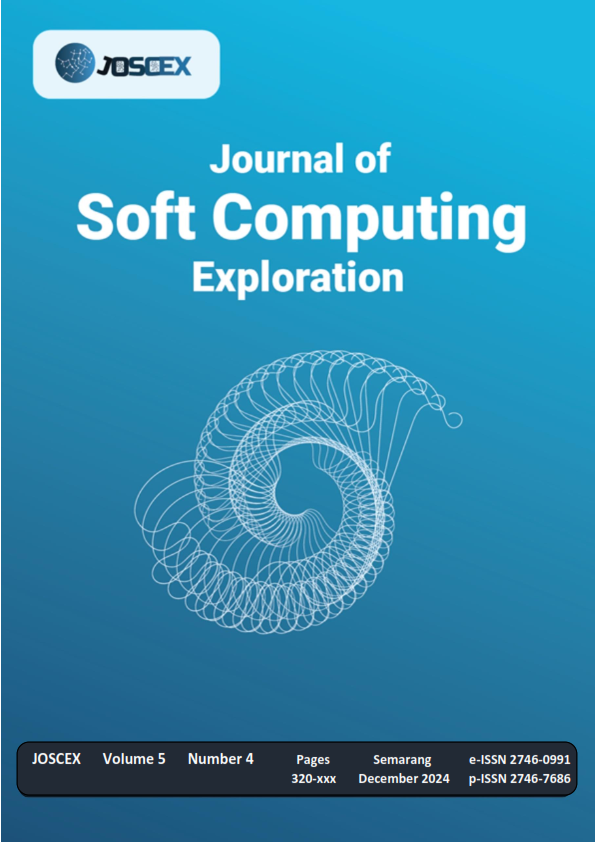Website based classification of karo uis types in north sumatra using convolutional neural network (CNN) algorithm
Main Article Content
Abstract
Indonesia is one of the largest archipelagic countries in the world. It has abundant cultural diversity including nature, tribes. One of the tribes in Indonesia is the Batak Karo tribe. Batak Karo is a tribe that inhabits the Karo plateau area, North Sumatra, Indonesia. Batak Karo has various cultures, one of which is a traditional cloth known as uis. Unfortunately, the Karo Batak community, especially the younger generation, has insufficient knowledge of the types of uis. Thus, a solution that is easily accessible both in terms of time, cost and experts in recognizing Uis is needed. This research aims to build a website-based application that can classify the types of Karo Uis. This research uses Convolution neural network (CNN) using Alex Net architecture, to get the best model this research compares several hyper parameters, namely learning rate of 10-1 to 10-4, and data division with a ratio of 70:30 and 80:20. The best model falls on a ratio of 70:30 and a learning rate of 10-4 with an accuracy of 98%, and a validation accuracy of 99%, then the model is stored in h5 format in this study successfully builds and implements the model into a web-based application.
Downloads
Article Details

This work is licensed under a Creative Commons Attribution-ShareAlike 4.0 International License.
References
M. Antara and M. Yogantari, “KERAGAMAN BUDAYA INDONESIA SUMBER INSPIRASI INOVASI INDUSTRI KREATIF,” SENADA (Seminar Nas. Manajemen, Desain dan Apl. Bisnis Teknol., vol. 1, pp. 292–301, 2018.
M. Drs. Sarjani Tarigan, Dinamika Orang Karo, Budaya dan Modernisme, Cetakan 1. Medan: Balai Adat Budaya Karo Indonesia, 2008.
I. F. Desiani, “Simbol Dalam Kain Ulos Pada Suku Batak Toba,” J. Ilmu Budaya, vol. 18, no. 2, pp. 127–137, 2022, doi: 10.31849/jib.v18i2.9466.
D. Handayani, Tata Rias Pengantin Batak Karo, 1st ed. agusnoviarp.an, 2019.
N. Siagian, A. Barus, and R. Ginting, “Fungsi dan Makna Uis Kapal dan Uis Nipes dalam Masyarakat Karo : Kajian Semiotik,” J. Syntax Imp. J. Ilmu Sos. dan Pendidik., vol. 2, no. 5, p. 439, 2021, doi: 10.36418/syntax-imperatif.v2i5.122.
T. Aritha, “Eksplorasi Visual Kain Tradisional Uis Gara Pada Produk Busana Siap Pakai Wanita,” J. Tingkat Sarj. Senirupa dan Desain, vol. 1, pp. 1–6, 2014.
M. Merselina Sembiring, E. Simanungkalit, Y. Nasution, and S. Aulia Mustika, “PELATIHAN PENGGUNAAN UIS KARO UPAYA MELESTARIKAN BUDAYA UNTUK KARANG TARUNA KUTABULUH BERTENG, KEC. TANAH PINEM, KAB. DAIRI,” unimed.ac.id, vol. 1, pp. 1–24, 2023.
_ Wesnina, “Perspektif Generasi Muda Suku Karo Terhadap Kain Tradisional Suku Karo: Sebuah Analisis,” J. Penelit. dan Pengemb. Sains dan Hum., vol. 4, no. 1, p. 10, 2020, doi: 10.23887/jppsh.v4i1.24394.
2011 Bruce, Intro to Deep Learning, vol. 53, no. 9. 2013. doi: 10.1017/CBO9781107415324.004.
M. A. Pangestu and H. Bunyamin, “Analisis Performa dan Pengembangan Sistem Deteksi Ras Anjing pada Gambar dengan Menggunakan Pre-Trained CNN Model,” J. Tek. Inform. dan Sist. Inf., vol. 4, no. 2, pp. 2443–2229, 2018.
T. A. Bowo, H. Syaputra, and M. Akbar, “Penerapan Algoritma Convolutional Neural Network Untuk Klasifikasi Motif Citra Batik Solo,” J. Softw. Eng. Ampera, vol. 1, no. 2, pp. 82–96, 2020, doi: 10.51519/journalsea.v1i2.47.
D. I. Swasono, M. A. R. Wijaya, and M. A. Hidayat, “Klasifikasi Penyakit pada Citra Buah Jeruk Menggunakan Convolutional Neural Networks (CNN) dengan Arsitektur Alexnet,” INFORMAL Informatics J., vol. 8, no. 1, p. 68, 2023, doi: 10.19184/isj.v8i1.38563.
Y. N. Fu’Adah, I. Wijayanto, N. K. C. Pratiwi, F. F. Taliningsih, S. Rizal, and M. A. Pramudito, “Automated Classification of Alzheimer’s Disease Based on MRI Image Processing using Convolutional Neural Network (CNN) with AlexNet Architecture,” J. Phys. Conf. Ser., vol. 1844, no. 1, 2021, doi: 10.1088/1742-6596/1844/1/012020.
F. Al Isfahani and F. Nugraha, “Web Service, Pengertian, Sejarah, dan Kegunaan,” no. March, pp. 1–43, 2020.
C. Shorten and T. M. Khoshgoftaar, “A survey on Image Data Augmentation for Deep Learning,” J. Big Data, vol. 6, no. 1, 2019, doi: 10.1186/s40537-019-0197-0.
J. W. TUKEY, Exploring Data Analysis, 1st ed. addison wesley, 1977. doi: 10.2307/jj.8500956.
M. D. Darojat, Y. A. Sari, and R. C. Wihandika, “Convolutional Neural Network untuk Klasifikasi Citra Makanan Khas Indonesia,” J. Pengemb. Teknol. Inf. dan Ilmu Komput., vol. 5, no. 11, pp. 4764–4769, 2021.
G. Krizhevasky, alex Sutskever, Ilya Hinton E, “ImageNet Classification With Deep Convolitonal Neural Networks,” Handb. Approx. Algorithms Metaheuristics, pp. 1–1432, 2012, doi: 10.1201/9781420010749.
L. Zhu, Z. Li, C. Li, J. Wu, and J. Yue, “High performance vegetable classification from images based on AlexNet deep learning model,” Int. J. Agric. Biol. Eng., vol. 11, no. 4, pp. 190–196, 2018, doi: 10.25165/j.ijabe.20181104.2690.
I. Goodfellow, “Deep Learning,” Prmu, pp. 1–10, 2016.
D. Normawati and S. A. Prayogi, “Implementasi Naïve Bayes Classifier Dan Confusion Matrix Pada Analisis Sentimen Berbasis Teks Pada Twitter,” J. Sains Komput. Inform. (J-SAKTI, vol. 5, no. 2, pp. 697–711, 2021.
H. Syahputra and A. Wibowo, “Comparison of Support Vector Machine (SVM) and Random Forest Algorithm for Detection of Negative Content on Websites,” J. Ilm. Tek. Elektro Komput. dan Inform., vol. 9, no. 1, pp. 165–173, 2023, doi: 10.26555/jiteki.v9i1.25861.

